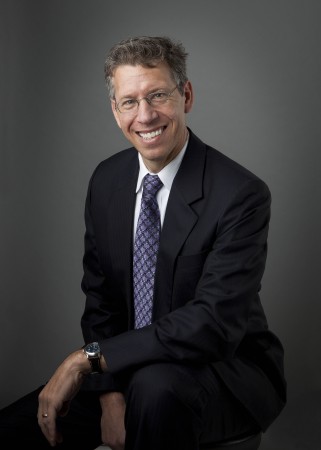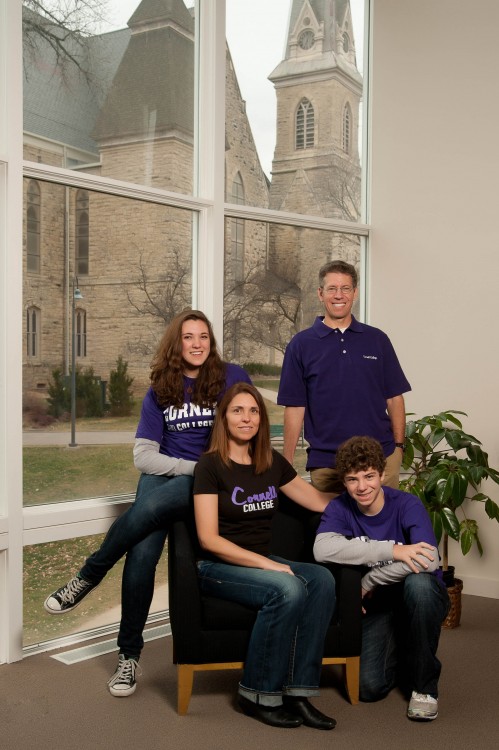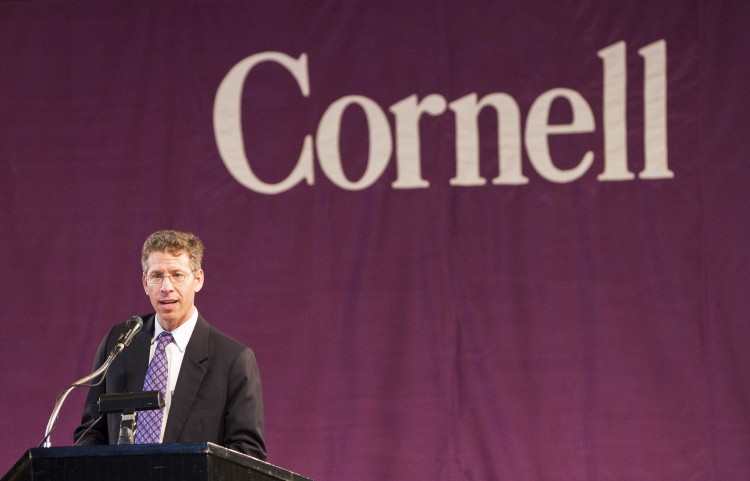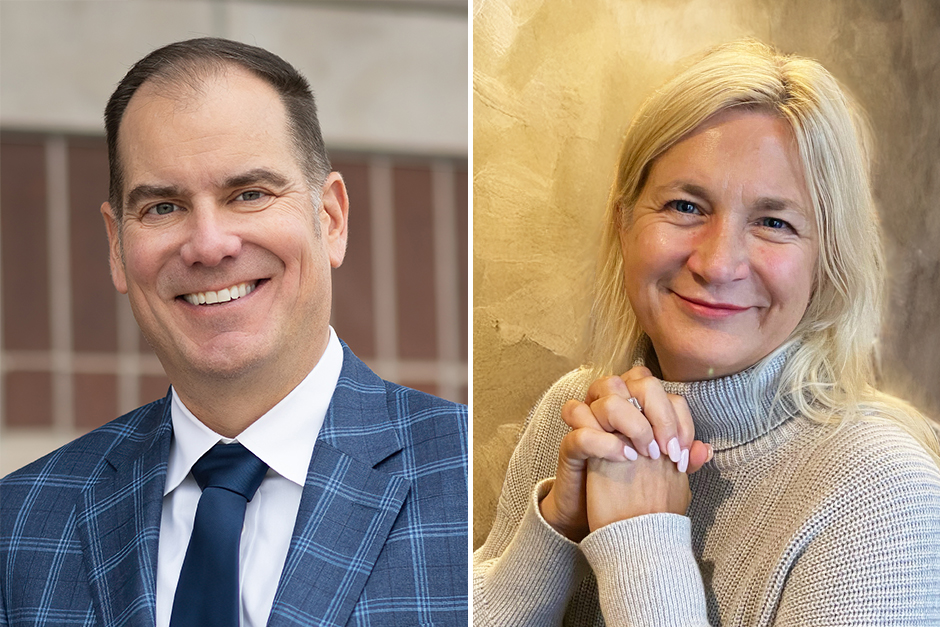Brand New Era
When Jonathan Brand arrived in Iowa the first time, he was coming from one place Cornell College is often confused with—Cornell University—and going to another, Grinnell College. The trip from Ithaca, N.Y., did not bode well.

“It was July 7, 1998, and probably close to 100 degrees. We were in our old Volvo wagon, U-Haul in tow. Our AC had died somewhere between Chicago and Iowa City,” he told the Cornell community during his recent introduction in King Chapel. “We had our two children in back—our daughter who was almost three and our son who had just turned one. And in the way back, we had our 70-pound dog, panting frenetically in the heat.
“Rachelle and I had not yet been to Iowa and we could not help but wonder—’what have we done’?”
It turned out that they’d formed an abiding relationship with liberal arts colleges. Brand spent seven years at Grinnell before becoming President of Doane College in Crete, Neb., in 2005. In October, he was named Cornell College’s 15th president. Brand, wife Rachelle LaBarge, and their 13-year-old son Ethan (their daughter Madeleine, 15, attends boarding school in New Hampshire) came to campus in late February to meet students, faculty, staff, and community members, a step in their journey from Doane to Cornell.
Drawn by a distinguished history
In preparation for his transition to Cornell, Brand read the Heywood, Thomas, and Milhauser history books, and, in his King Chapel speech, he said the books made absolutely clear how Cornell has earned its reputation as a national liberal arts college. That reputation is what convinced him to pursue the presidency.
“I thought, ‘Wow, this is a school with the kind of past, the kind of location, the kind of values that really speak to me,'” he said. “That’s why I’m coming here. To join an institution that has always been forward-looking and focused on excellence and social improvement above all else.”
Brand took his first step toward becoming part of that on stage in King Chapel, introduced by board of trustees chair-elect John McGrane ’73. As Ethan and LaBarge sat in the front row—Ethan in a purple sweater, white shirt, and purple tie, LaBarge in a suit with a lavender top—Brand mounted the stage, and told the story of his family’s first, fateful road trip to Iowa.
A sense of the historical accomplishments ran through his conversations during his visit. He knows what’s been done—the Berry Center, Dimensions,Cornell Fellows, the $105.8 million Extraordinary Opportunities Campaign—in the past decade, what strides Cornell has made to provide each student with a world-class education rooted in the traditional liberal arts but looking toward the future. He said he knows that liberal arts colleges provide invaluable skills, the kind of skills employers want. And he knows that liberal arts colleges, including Cornell, need to do a better job telling the world what they actually do for students. Too often, liberal arts schools are defensive about their education, even though they teach the critical thinking and synthesis skills so in demand by employers.
“Somehow, liberal arts colleges don’t get the message across,” he said. “At Cornell, we need to be shameless about what is great here. Accurate. Academically focused. But shameless.”
And he knows something else, too, he said: That a school like Cornell cannot rest on its laurels. The tradition of the liberal arts is one of innovation with a healthy sense of respect for history. It was that way in 1890, he said, when Cornell’s board of trustees expressed a desire for all faculty members to have Ph.D.s, and it was that way just a few years ago when Dimensions, the Berry Center, and other programs were started. And it needs to remain that way in the future, he said, offering expanded opportunities for faculty-student research and more chances for hands-on, applied learning outside the classroom. These experiences exist already, and, Brand said, they need to continue, while people must always bear in mind the historic mission of Cornell and of liberal arts education.
What Brand terms the “beautiful, almost perfect oxymoron” of liberal arts education is that it’s firmly rooted in the past, and also has the potential to be cutting edge at the same time. The world keeps changing—he gives the example of computer science, a major most liberal arts colleges wouldn’t have offered 25 or 30 years ago, but is now ubiquitous—and colleges need to recognize and respond to those changes. At the same time, the core values of the liberal arts, such as understanding the human condition, synthesizing different topics into a coherent whole, engaging in critical thinking, and communicating powerfully are never and will never be obsolete.

An ability to connect
Brand and LaBarge had a whirlwind nine-hour tour of campus, starting with a photo shoot and an interview for the Cornell Report and the Cornellian, followed by Brand’s speech, lunch with the Student Senate Executive Committee, a tour of the college’s athletic facilities, an introduction to the facilities management staff, and back-to-back receptions for students, faculty and staff, and community members.
Meeting so many people can be daunting. It’s not possible to really understand a place in the span of a workday, after all, but the pair gave every person they met their full attention.
Among the first words out of Brand’s mouth upon meeting Tom Kirk, a sophomore and the news editor for The Cornellian, were, “How’s your block going?” Then: “I’m so used to saying ‘How is your semester going?’ but that just doesn’t work here.”
That was a question Brand would ask again and again during his visit.
“During lunch with President Brand and Rachelle, their passion for engaging with the students and their desire to connect with the community was evident,” said Taylor Koch, then-Student Senate president. “President Brand showed his attentiveness to what students are up to on a daily basis, asking as many questions as possible, and already asking how he can engage with students and student organizations on campus. I feel comfortable speaking for all who were at the lunch in saying that we wish we could have had even more time because we had so much to share and he had so many ideas for us as well.”
His drive to connect continued throughout a day that began with a run to explore both campus and Mount Vernon. He took the chance to observe how things were laid out, took a route into town, and then realized that there was no way to get to Brackett House without running up a steep hill.
“It’s physically, geographically, and topographically impossible,” he said. A year-round runner, he was offered the chance to run with Cornell athletes—something he said he’d consider, but only when they were tired.
At facilities management, the couple was delighted to be greeted with a poster signed by the entire staff. Brand told them how much he and his family had been impressed with the beauty of the campus, and that he knew their work was essential to that.
Even community members got a taste of Brand’s personality.
“It’s clear to me Jonathan and Rachelle will be engaged with the Cornell-Mount Vernon-Lisbon community,” said Jake Krob, publisher and editor of theMount Vernon-Lisbon Sun and an honorary alum. “At the reception, I handed Rachelle a copy of the most current Sun edition. Rachelle genuinely appreciated getting the copy early, as theirs hadn’t arrived in Nebraska before they’d left. It was a clear indication to me that they care about keeping up on the news of what will be their new community.”
That focus on the people isn’t surprising to those who know Brand well. Kim Miller Jacobs ’83, vice president for student leadership at Doane College, said he’s highly visible, attending as many events as he can, and taking time to walk around campus and visit with students, faculty, and staff.
Jacobs has a double connection to Cornell. Not only is she an alum, her daughter, Kalissa Holdcraft, is a Cornell sophomore, and joined Brand and LaBarge for lunch as a member of the Student Senate Executive Committee. In fact, as Brand made his way from Brackett House to King Chapel for his speech, he carried with him a book bag filled with supplies from Jacobs to her daughter.
“Jonathan leads utilizing collaboration and communication,” she said. “He shares information and feedback and is always accessible. He listens carefully to the opinions and ideas of others and trusts the judgment of those with whom he works. He does not micro-manage. Jonathan is the most supportive president I have ever worked for.”
Brand’s people skills are something Russell Osgood thinks has made Brand so successful. Osgood, former president of Grinnell College, met Brand at Cornell University Law School, where Osgood taught and Brand studied. When Brand returned to Cornell University, he worked for Osgood, and it was Osgood who brought Brand to Grinnell.
“Jonathan has the ability to connect with large cross-sections of people,” Osgood said. “He has a great capacity to relate to faculty, students, and staff, and he’s uniquely successful in how he can relate to them and be liked by them.”

Son of a poet and a principal
Brand was born into a family of educators. His father was a principal, and his mother was an English professor, poet, and creative writer. Education was part of his life from the beginning. He majored in history and French at the University of Wisconsin-Madison and spent a year abroad in Paris. That year, he said, had its challenges, but it shaped his life too.
He earned a master’s degree in French literature from the University of Michigan and spent three years in California teaching French. He then decided to switch gears and go to law school.
“It was a moment to decide what was the next step in life,” Brand said of the decision. “It happens throughout life, this perpetual state of self-reflection and planning.”
He practiced law for only a year before returning to higher education, but in law school he learned more than facts and legal precedents; he learned how to draw together different strands of information and weave them into a coherent whole.
“When I look back on my law school experience, what I’m most thankful for is what students at Cornell College actually learn as undergraduates,” he said. “I was engaged in the rigorous intellectual process of synthesizing and creating a unified sense of knowledge.”
After working at Cornell University for a year, he became special assistant and counsel to President Osgood at Grinnell, a position he held for seven years. In addition to teaching in political science, Brand gained valuable administrative experience at Grinnell overseeing institutional and budget planning as well as the college’s gallery, facilities management, and office of community enhancement.
In 2005, he accepted the position as president of Doane, where he built up a run of impressive achievements: Exceeding the goal for the college’s capital campaign, attaining two consecutive years of record enrollment, completing several new facilities, and overseeing the addition of majors in biochemistry and journalism, among others.
Much like the liberal arts colleges he’s served for more than a decade, Brand is both grounded in the past and looking toward the future. There’s not a much better example than his reading material: A perfect day for him would include a cup of coffee, a long run, The New York Times and reading Rabelais. He doesn’t teach French anymore, but that hasn’t kept him from 16th-century French literature. LaBarge is an avid reader as well, and holds undergraduate and master’s degrees in English literature, from the University of California-Berkeley and the University of California-Riverside, respectively.
Ready to learn
Brand has a lot of ideas about what liberal arts colleges can and should be doing better, particularly when it comes to modernizing. Cornell must stay rooted in its history, but the changes that have already started need to continue.
“The external environment keeps changing,” he said. “Liberal arts colleges need to be alive to what’s fundamental to the liberal arts, but also recognize the need for greater experiences off campus, more opportunities for research with faculty, and more opportunities to apply skills in a practical setting. We have an opportunity to help our students take all of their courses and create a unified sense of knowledge—how they understand the world around them through their personal lens.”
That doesn’t mean there will be major changes when he officially becomes president on July 1. First, he said, he understands that to lead effectively, he needs to become a member of the community. To him, that means sustained dialogue about what the students want and need, where faculty interest lies, and what best suits the college’s long-term strategy.
Secondly, he said, Cornell isn’t a place that needs a drastic, top-down shake-up. A symbol of this is that Brand asked Jim Brown, who spent the year as interim president, to stay on as special assistant to the president, the role he held from 2005 through 2009.
Brand said he believes in the power of groups of people to make better decisions. That concept of shared governance, where faculty, staff, students, and trustees have input into where the college is heading, is central to Brand’s leadership style.
“I know enough to know I don’t have all the answers,” he said.
That respect for shared decision-making goes beyond just thinking it leads to better outcomes. Brand said that the way faculty, staff, and administrators interact with each other provides a model for students. When they see effective leadership, a search for consensus among diverse constituencies, and respectful communication between all parties, then they learn a valuable lesson about how they should interact with others after they graduate. The educational mission of Cornell extends far beyond the classroom, and offering students examples of good leadership and constructive interaction is part of that.
Brand told the King Chapel audience he wants to model effective leadership to the entire community, both on campus and off.
“I promise that when I make a mistake, I will own it and I will learn from it,” he said. “And I will surely make mistakes.”
Values alumni connections
Part of the strength of a college like Cornell, Brand said, is the alumni. At 12,000 or so strong, they’re a massive body of people with a shared sense of the importance of the college and a desire to see their alma mater endure and prosper.
Their support takes many forms: coming back to campus to speak or to teach, helping advise young alumni or current students about where to live or career choices, helping advise the college as decisions are made, and giving financial support.
That last item can sound mercenary, Brand said, but it isn’t. Rather, the act of supporting one’s college is deeply personal. It’s an outward sign of a profound inner connection, and the idea that support enhances something you care about is gratifying.
“One of the best aspects of American higher education is that we are able to invest in institutions that matter to us. To ensure that future generations are able to have what past generations had, and hopefully even more,” he said.
And alumni-student connection works both ways. “The experience that students communicate to alumni is so much more powerful than anything a president or administrator can communicate,” Brand said, adding that strengthening alumni relationships with Cornell enriches student lives, enhances the quality of education, and solidifies the college’s continued success.
“At small colleges, the alumni are particularly important,” Brand said. “It’s true at Cornell. Alumni are passionate about their connections because they feel so transformed by their time here.”

(Photo by Jamie Kelly)
Champion for Cornell
Brand and LaBarge spent most of their time on campus meeting people. From facilities staff to the athletic department, from students and staff to community members, their day was filled with lines of people waiting to greet them.
It was the first step of what Brand is sure will be a long process of joining the community. It’s a start, but only a start.
Next comes the enjoyable work of really getting to know people. At Doane, Brand and LaBarge had faculty over for dinner in groups of 10. Those groups met once a month for three months and during the dinner parties discussed how they came to Doane, Doane’s history, and how they were helping to create Doane’s future. The pair had students over regularly, especially after groups came back from off-campus study experiences.
The beginning of their time at Cornell will likely look much the same. One thing they already know is that they want to have each and every student over to the President’s House, and though they haven’t determined the format, it will include food.
After that, there are many priorities to consider. The Commons looms largest, and fundraising continues with groundbreaking planned for summer of 2012 (see news digest item). There are academic tasks, too. The implementation of an eight-block calendar. The expansion of the programs that have made Cornell increasingly distinctive: The Berry Center, Cornell Fellows, Dimensions, Pre-Law, Off-Campus studies. Planning for the opening of the McLennan Center in Chicago. The list goes on.
All that might seem daunting, but this time when Brand and LaBarge come to Iowa, they won’t be wondering what they’ve done. They know that they’re coming to Cornell because they want to build on the successes the college has already had and to lead the college to even greater heights. That’s a mission that Brand is taking seriously, as he told the students, faculty, staff, and community members gathered in King Chapel, and dozens of others watching a live webcast of the speech.
“I promise,” he said “that I will champion Cornell College and its distinctiveness in every setting—nationally, internationally, and in the higher education community.”



